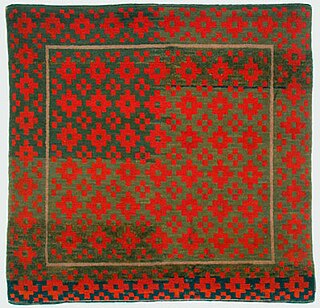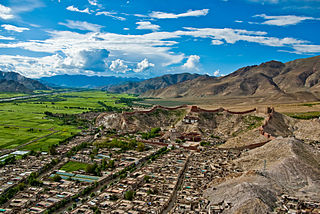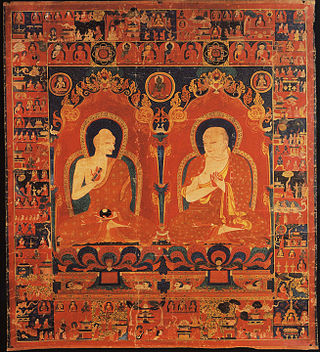Related Research Articles

Tibetan rug making is an ancient, traditional craft. Tibetan rugs are traditionally made from Tibetan highland sheep's wool, called changpel. Tibetans use rugs for many purposes ranging from flooring to wall hanging to horse saddles, though the most common use is as a seating carpet. A typical sleeping carpet measuring around 3 ft × 5 ft is called a khaden.

Samzhubzê District is a district in the Tibet Autonomous Region of the China, and the administrative center of the prefecture-level city of Shigatse. Prior to 2014 it was known as the county-level city of Shigatse. It was the ancient capital of Ü-Tsang province and is the second largest city in Tibet with an estimated population of 117,000 in 2013. Samzhubzê is located at the confluence of the Yarlung Tsangpo River and the Nyang River, about 250 km (160 mi) southwest of Lhasa and 90 km (56 mi) northwest of Gyantse, at an altitude of 3,840 metres (12,600 ft).

Lobsang Trinley Lhündrub Chökyi Gyaltsen was the tenth Panchen Lama, officially the 10th Panchen Erdeni, of the Gelug school of Tibetan Buddhism. According to Tibetan Buddhism, Panchen Lamas are living emanations of the buddha Amitabha. He was often referred to simply as Choekyi Gyaltsen.

The 2nd Dalai Lama, Gedun Gyatso, was also known as Yonten Phuntsok, or Gedun Gyatso Palzangpo. He was ordained at Tashilhunpo Monastery at Shigatse, and later resided at Drepung Monastery in Lhasa. He was posthumously entitled as the 2nd Dalai Lama.

Gyantse, officially Gyangzê Town, is a town located in Gyantse County, Shigatse Prefecture, Tibet Autonomous Region, China. It was historically considered the third largest and most prominent town in the Tibet region, but there are now at least ten larger Tibetan cities.

Shigatse, officially known as Xigazê, or Rikaze, is a prefecture-level city of the Tibet Autonomous Region of the People's Republic of China. Its area of jurisdiction, with an area of 182,000 km2 (70,271 sq mi), corresponds to the historical Ü-Tsang region of Tibet.

Tashi Lhunpo Monastery is an historically and culturally important monastery in Shigatse, the second-largest city in Tibet. Founded in 1447 by the 1st Dalai Lama, it is the traditional monastic seat of the Panchen Lama.

Shalu Monastery is small monastery 22 kilometres (14 mi) south of Shigatse in Tibet. Founded in 1040 by Chetsun Sherab Jungnay, for centuries it was renowned as a centre of scholarly learning and psychic training and its mural paintings were considered to be the most ancient and beautiful in Tibet. Shalu was the first of the major monasteries to be built by noble families of the Tsangpa during Tibet's great revival of Buddhism, and was an important center of the Sakya tradition.

Butön Rinchen Drup, (1290–1364), 11th Abbot of Shalu Monastery, was a 14th-century Sakya master and Tibetan Buddhist leader. Shalu was the first of the major monasteries to be built by noble families of the Tsang dynasty during Tibet's great revival of Buddhism, and was an important center of the Sakya tradition. Butön was not merely a capable administrator but he is remembered to this very day as a prodigious scholar and writer and is Tibet's most celebrated historian.

Narthang Monastery is a monastery located 15 km (9.3 mi) west of Shigatse in Tibet. Founded in 1153 by Tumtön Lodrö Drakpa, a student of Sharawa Yonten Drak. Narthang was an influential Kadam monastery, and the fourth great monastery of Tsang, with Shalu Monastery, Sakya and Tashilhunpo. Narthang was first famous for its scriptural teaching and monastic discipline. After the fourteenth century it gained great eminence as the oldest of Tibet's three great printing centres.
Rinchen, meaning "treasure", is a Tibetan name, used by speakers of various Tibetic languages. It is also used as a given name by Mongols, seen as early as the Yuan dynasty. As a Mongolian name, it has various spellings such as Rinchin, Renchin, or Erinchin. People with Rinchen as one of their given names, or as a patronymic, include:

Namling County is a county of Shigatse in the Tibet Autonomous Region, China.

Tsangpa was a dynasty that dominated large parts of Tibet from 1565 to 1642. It was the last Tibetan royal dynasty to rule in their own name. The regime was founded by Karma Tseten, a low-born retainer of the prince of the Rinpungpa dynasty and governor of Samdrubtsé in Tsang since 1548.

Drongtse Monastery is a Tibetan Buddhist monastery was formerly one of the most important Gelug monasteries in Tsang, Tibet. There was also a chorten there.
Sherab may refer to:
Shalu may refer to:

The Shigatse Dzong, also known as Samdruptse Dzong, is located in Shigatse, Tibet, China. It is spelt Rikaze Dzong.
The Bodongpa or Bodong tradition, is one of the smaller traditions of Tibetan Buddhism falling outside the classification of the four main schools.

Although there were many householder-yogis in Tibet, monasticism was the foundation of Buddhism in Tibet. There were over 6,000 monasteries in Tibet. However, nearly all of these were ransacked and destroyed by Red Guards during the Cultural Revolution. Most of the major monasteries have been at least partially re-established, while many others remain in ruins.
References
- ↑ Namgyal, Tsering (September 2012). "Buton Rinchen Drub". The Treasury of Lives: Biographies of Himalayan Religious Masters . Retrieved 2013-08-11.
- ↑ "Shalu Monastery in Shigatse, Tibet". Warrior Tours. Archived from the original on 2013-10-29. Retrieved 2013-10-28.